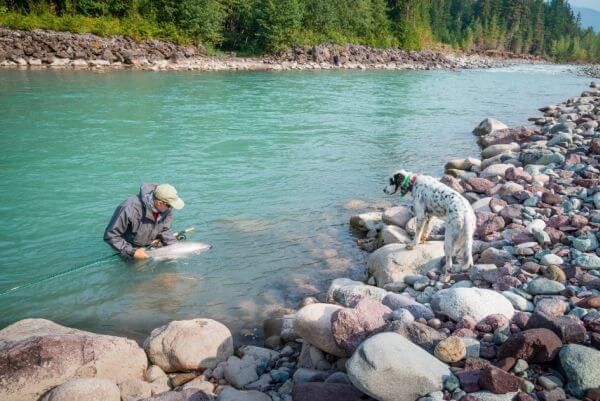Editor’s Note: My friend, Felton, definitely enjoys more fishing opportunity than I do and his angling skills far surpass mine. Good thing for the fish as his “keep ’em wet” best practices means the many he brings to hand have a very good chance of procreating and sustaining the fishery resource. This month Felton shares some valuable pointers and links to help all of us as a fly fishing club do our best to keep ’em wet. LKH

Felton Jenkins preparing to gently release a steelhead
Since our club members release most of the fish they catch, we need to be as great at releasing fish as we are at catching them. Also, when fishing many rivers in the PNW, we can encounter threatened and endangered fish, like Snake River steelhead and chinook. There’s no excuse for harming these fish if at all possible. There are some great resources out there that can help us learn best practices and improve our game on the water.
Check out www.KeepEmWet.org . This movement is now a non-profit started by fisheries scientists Sascha & Andy Danylchuk. They are both avid anglers who happen to be married and who have conducted studies around the world on handling & releasing fish. Their approach starts with three main principles:
1: MINIMIZE AIR EXPOSURE (10 seconds or less, just once, is important)
2: ELIMINATE CONTACT W DRY SURFACES (dry hands & net, boat bottom, ground)
3: REDUCE HANDLING (Use barbless hooks, rubber nets, forceps, etc.)
Building on the 3 principles are 12 Tips to help implement the principles. See https://www.keepemwet.org/#keepemwet-tips . Most of these tips are common sense, but not all are well known and practiced enough. Fish need oxygen, but they can only get it as aqueous dissolved oxygen. I had heard that we should think about how long we can hold our breath as a guideline for a fish. But Sascha likened it to having your head stuck under water right after you crossed the finish line of a marathon run. Yikes. Ten seconds now sounds like a long time!
A fish is stressed and maybe exhausted when we bring them to hand, just when they need oxygen the most. Too much time out of the water for pictures, too much contact with dry hands/ground/boat floor etc. and too much time being restrained and handled (including while in the water) can lead to mortality, either now or later. Even a fish that seems to swim away fine but has not been handled well could suffer delayed mortality from predation, disease or just not fully recovering from the encounter. If a fish is solidly hooked in the gills or back in the throat, clip the tippet and leave the fly. If the fish is bleeding from the gills, then consider harvesting the fish if legal to do so. Anyway, Keep Fish Wet does not mean don’t ever harvest a fish.

Sandy steelhead
Everybody loves fish pictures, and some people like images of themselves with ichthyo-fauna. But keep the fish mostly in the water, or just barely out of the water, while still dripping, for a quick picture. I’m guilty of doing it imperfectly in the past, and I bet I still make mistakes. Everyone can get better at this, just like everyone can get better at flyfishing. Keep at least the fish’s head & gills in the water as much as possible, while facing upstream in flowing water. The above picture is one I got on the Sandy a few winters ago. More people want to see the fish than my face. And we don’t need a picture of them all; just ask my wife Karen.
I recommend listening to April Vokey’s podcast with Andy & Sascha at April’s website, www.AnchoredOutdoors.com , episode #155. I understand April gained some fans when she presented to FCO a few years ago, and she has a bunch of good podcasts on her site or at “Anchored” on your podcast app. Also, the Conservation Angler has prepared a document “10 Ways to be a Conservation Angler.” One of their important guidelines is to cease fishing for salmonids when the water temperature is greater than 68 degrees F, or 20 C. Higher water temps mean lower dissolved oxygen. Keep that in mind when going out for summer steelhead. https://theconservationangler.wordpress.com/2017/08/14/ten-ways-to-be-a-conservation-angler/
One more word on barbless hooks. We really do not need the barb to land fish when you play a fish correctly & quickly. A lot of unnecessary handling come from digging out a barbed hook, it’s bad on the fish and you are wasting fishing time. If it’s not already barbless, pinch the barb on a new fly when you put it in your flybox. And make sure your older flies are pinched when you take them out. Ask your fly shop to carry barbless flies whenever possible. Not only is it safer for the fish, it’s a lot safer for you. Many of us have gotten a fly stuck in the skin, and if not the skin then your waders, jacket, etc. A few days before my wedding in 2004 I came home with a large, barbed saltwater fly stuck in my cheek; it was really windy. Not cool. Another word to the wise, always protect your eyes with glasses when fishing. Have fun out there and treat the resource with respect.
By Felton Jenkins, March 2020

Steelhead released as Dean (the dog) looks on.

